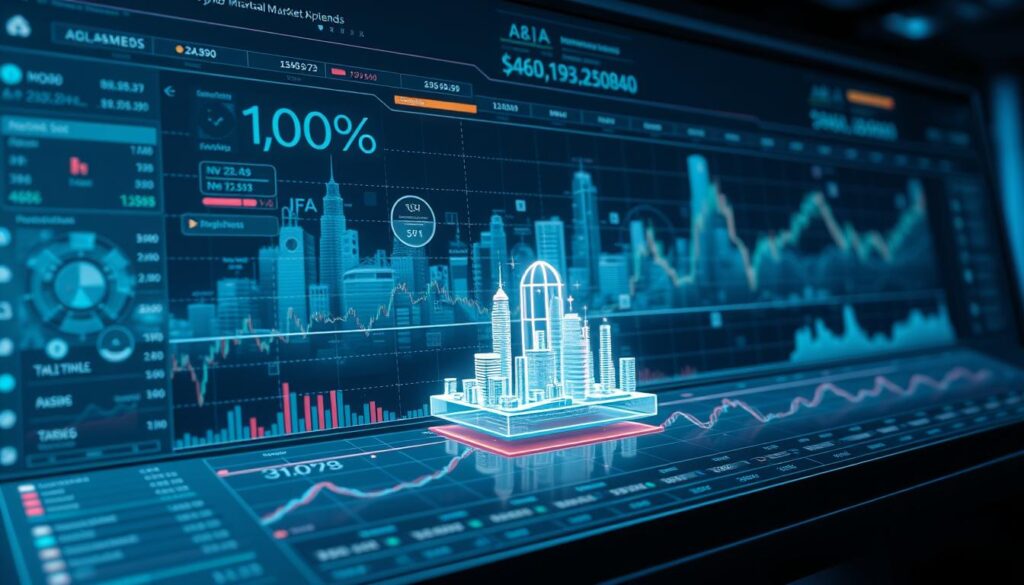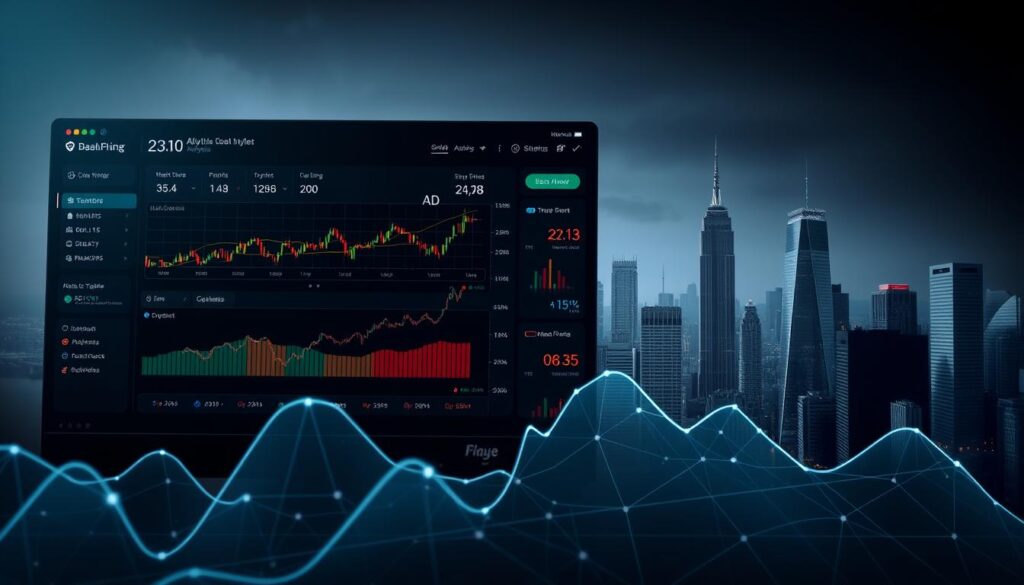Modern investment strategies are evolving with tools that automate complex processes. Advanced algorithms now handle repetitive tasks, analyzing patterns across global markets faster than manual methods. These systems operate nonstop, executing strategies even when users focus on personal or professional priorities.
Emotion-free decision-making sets these tools apart. Unlike traditional approaches, they rely on mathematical models rather than impulsive reactions. This reduces errors caused by uncertainty or excitement during volatile periods. Users define parameters upfront, letting the technology manage execution with precision.
Continuous monitoring allows these systems to spot opportunities across multiple exchanges simultaneously. They adapt to shifting conditions in real time, responding to price changes or news events instantly. This creates efficiency for investors seeking consistent results without constant screen time.
Key Takeaways
- Automated systems execute strategies 24/7 without manual oversight
- Data-driven decisions eliminate emotional biases in market interactions
- Algorithms process vast amounts of information faster than human analysis
- Multi-market tracking identifies opportunities across global exchanges
- Pre-set rules ensure disciplined adherence to investment plans
- Real-time adjustments respond to sudden market shifts
- Technology integration enhances precision in volatile environments
Overview of Artificial Intelligence in Cryptocurrency Trading
Smart systems now drive decisions in fast-paced financial environments. These tools analyze global price movements and social sentiment simultaneously, identifying trends humans might overlook. By combining historical patterns with real-time updates, they offer insights that reshape investment approaches.
Revolutionizing Market Interactions
Data-processing capabilities allow these systems to execute actions within milliseconds. Unlike manual methods, they cross-reference multiple indicators like volume spikes and liquidity changes. This speed helps capitalize on fleeting opportunities before markets adjust.
Strategic Advantages for Users
Round-the-clock operation ensures no potential trade goes unnoticed. Users benefit from:
- Bias-free execution based on predefined rules
- Instant adaptation to regulatory changes or breaking news
- Simultaneous tracking across 20+ exchanges
Advanced algorithms also backtest strategies against years of market behavior. This reduces guesswork while improving consistency in unpredictable conditions. Investors gain institutional-grade tools without needing technical expertise.
Introduction to AI-Powered Crypto Trading Bots
Digital assistants now handle market operations once managed through spreadsheets and guesswork. These programs combine pattern recognition with rapid execution, acting on opportunities humans might miss during sleep or work hours. Their architecture blends mathematical models with live data streams to maintain competitive edges.
Three primary variants dominate this space. Rule-based versions follow simple “if-then” commands, like buying when prices dip 5%. Machine learning models evolve strategies by analyzing historical outcomes. Hybrid systems merge preset rules with adaptive logic for balanced decision-making.
How Automated Trading Enhances Efficiency
Speed becomes critical in volatile markets. These tools execute orders in milliseconds after identifying signals. Manual traders often miss brief windows when values shift rapidly across exchanges.
Multi-exchange monitoring allows simultaneous action on various platforms. A bot might buy Ethereum on one market while selling Litecoin on another. This cross-platform agility maximizes profit potential during coordinated price movements.
Continuous operation eliminates downtime. Markets never close globally, and these systems track Asian, European, and American sessions without fatigue. Users gain peace of mind knowing their strategies work while they focus on other priorities.
Understanding Market Trends Through AI
Decoding price fluctuations requires more than human observation. Advanced systems process live feeds from exchanges, news outlets, and social platforms simultaneously. They cross-reference these streams to detect emerging patterns invisible to manual methods.

- Technical metrics like moving averages and volume spikes
- Fundamental factors including regulatory updates
- Sentiment shifts across forums and news headlines
Machine learning models compare current conditions against decades of historical behavior. This reveals recurring cycles and anomaly detection triggers. When Bitcoin’s volatility spiked 30% last month, systems flagged similar 2019 patterns within seconds.
Predictive engines forecast potential outcomes using probability matrices. They calculate multiple scenarios based on liquidity changes or macroeconomic shifts. These forecasts update every 15 minutes, adjusting strategies for maximum adaptability.
Continuous learning refines accuracy over time. Every executed trade feeds back into the system, sharpening future decisions. This creates self-improving models that evolve with global financial landscapes.
Deep Dive: What is an Artificial Intelligence Cryptocurrency Trading Platform
Integrated systems now power modern financial operations by connecting data streams with execution engines. These ecosystems combine automation, social features, and portfolio tracking while supporting 10,000+ digital assets. They link directly to exchanges like Binance through secure APIs, enabling cross-market actions without manual intervention.

Core components create a seamless environment for diverse strategies. User dashboards display real-time analytics alongside customizable indicators. Backtesting modules let traders simulate strategies against historical market behavior before risking capital. Security layers encrypt sensitive data while monitoring for suspicious activity 24/7.
Three service tiers cater to different experience levels:
- Basic: Pre-configured bots execute simple buy/sell rules
- Intermediate: Custom strategy builders with risk management tools
- Advanced: Machine learning models that adapt to market shifts
Social features allow users to mirror successful traders’ approaches automatically. This blends community wisdom with automated execution, creating collaborative opportunities. Multi-exchange tracking ensures no arbitrage chance goes unnoticed across global markets.
APIs form the backbone, connecting price feeds, order books, and execution protocols. These integrations enable simultaneous actions across Coinbase Pro and other venues. Real-time alerts notify users about threshold breaches or emerging patterns, keeping them informed without constant monitoring.
Exploring Top AI Trading Bots: A Product Roundup
Market leaders now offer specialized tools catering to diverse investment approaches. These solutions streamline operations across exchanges while prioritizing security and speed. Let’s examine five prominent options reshaping how users interact with digital markets.

ArbitrageScanner and Cryptohopper: Cross-Market Efficiency
ArbitrageScanner simplifies profit opportunities across 40+ centralized and decentralized exchanges. Its API-free design minimizes security risks while identifying price gaps between spot and futures markets. Users report monthly gains between 15-50% through automated spread capture.
Cryptohopper supports 75 digital assets with direct integration into major trading venues. The platform combines automated execution with social features, letting users mirror top performers’ strategies. Portfolio rebalancing tools help maintain target allocations during volatile periods.
TradeSanta, 3Commas, and Photon: Strategic Diversity
TradeSanta’s interface welcomes newcomers with one-click strategy activation. Algorithms handle both long and short positions, adapting to bullish or bearish conditions. Preconfigured templates reduce setup time while maintaining risk parameters.
3Commas stands out with dollar-cost averaging bots and grid strategies. Its SmartTrade terminal enables precise limit orders with trailing stop-loss protection. Advanced users customize entry/exit rules across multiple timeframes.
Photon dominates Solana-based transactions with unmatched speed. Real-time chart updates arrive 5-10 seconds faster than competitors, enabling rapid reactions to blockchain activity. This edge proves critical in fast-moving DeFi environments.
Essential Features of Cutting-Edge Trading Bots
Sophisticated systems now dominate digital markets through precision and adaptability. These tools combine live market scanning with self-improving algorithms to maintain competitive edges. Their architecture prioritizes both speed and accuracy, processing terabytes of information faster than traditional methods.

Advanced Data Analysis and Predictive Modeling
Top-tier bots analyze 50+ technical indicators simultaneously. They track social sentiment shifts and liquidity changes across decentralized exchanges. Historical pattern recognition helps identify recurring opportunities during volatile periods.
Machine learning models forecast price movements using probabilistic scenarios. These systems update predictions every 90 seconds, adjusting strategies for emerging trends. Backtesting modules validate approaches against years of market behavior before execution.
| Feature | Basic Bots | Advanced Systems |
|---|---|---|
| Data Sources | Price charts only | News APIs, social feeds, on-chain metrics |
| Strategy Customization | Pre-set templates | Drag-and-drop builders |
| Risk Management | Basic stop-loss | Dynamic position sizing |
| Learning Capability | Static rules | Self-optimizing algorithms |
Customizable dashboards let users set profit targets and risk thresholds. Multi-exchange support enables simultaneous actions across Coinbase and Kraken. For those seeking optimized solutions, advanced trading software combines these features with institutional-grade security protocols.
Real-time alerts notify users about critical market shifts through SMS or email. Transparent reporting tools track performance metrics like win rates and ROI. These capabilities empower traders to refine strategies while maintaining full control over their portfolios.
Key Advantages of AI-Powered Trading Platforms in Crypto Trading
Modern financial tools have transformed how markets operate. Advanced systems work continuously, scanning price movements across time zones. This nonstop monitoring captures opportunities during late-night hours or weekend shifts.
Emotion-free execution prevents costly mistakes. Mathematical models ignore fear or excitement, sticking to predefined rules. Users avoid impulsive decisions that often derail manual strategies.
Speed becomes critical during rapid value changes. Automated tools execute orders in 0.8 seconds versus human traders’ 45-second average. This difference determines profit margins in fast-moving conditions.
- 24/7 availability across global exchanges
- Real-time alerts for breaking news affecting values
- Personalized strategy adjustments based on portfolio goals
Scalability lets individual investors compete with institutions. One user can manage 15 currency pairs simultaneously through automated tracking. Performance remains steady during market chaos, maintaining analytical rigor when emotions run high.
| Feature | Manual Approach | Automated Solution |
|---|---|---|
| Reaction Time | Minutes/Hours | Milliseconds |
| Market Coverage | 1-2 Exchanges | 20+ Platforms |
| Error Rate | High |
Consistent updates keep strategies relevant. Systems adapt to regulatory changes or new coin listings instantly. Backtesting against historical patterns ensures methods work before real-money deployment.
Managing Risk and Security in Trading Tools
Protecting investments requires more than strategy—it demands ironclad safeguards. Advanced systems combine protective measures with automated oversight to shield assets from threats. These protocols work silently in the background while strategies execute.
Core Protective Measures
Automated stop-loss orders prevent catastrophic losses during sudden crashes. Users set thresholds that trigger instant sell actions when values dip. Take-profit rules lock gains automatically, removing emotional attachment to positions.
Diversification tools spread exposure across multiple assets. This reduces reliance on single market movements. Portfolio balancing features adjust allocations weekly based on performance metrics.
- Bank-grade encryption for data transfers and wallet storage
- Mandatory two-step verification for account access
- API key permissions limiting third-party interactions
Leading systems undergo quarterly penetration testing by external auditors. Funds remain in cold storage until transactions require liquidity. Insurance coverage protects against exchange breaches or technical failures.
| Security Feature | Basic Systems | Advanced Solutions |
|---|---|---|
| Fund Storage | Hot wallets only | 95% cold storage |
| Account Recovery | Email-based | Multi-signature approval |
| Compliance | Basic KYC | Global regulatory adherence |
Real-time monitoring flags unusual login attempts or large withdrawals. Users receive instant alerts through preferred channels. These layers create fortress-like protection for digital assets.
Evaluating Trading Strategies Offered by AI Bots
Selecting effective market approaches requires matching bot capabilities to personal goals. Modern systems support multiple methods tailored to risk tolerance and time horizons. Users benefit from testing options before committing real funds.
Customization, Backtesting, and Algorithmic Trading
Grid approaches place orders at set intervals to capitalize on price swings. Arbitrage systems exploit price gaps between exchanges for low-risk gains. Dollar-cost averaging bots spread purchases over time to reduce volatility impact.
Backtesting tools let users simulate strategies against historical data. This reveals how methods perform during bull runs or corrections. Algorithmic models adjust parameters automatically based on shifting market conditions.
Copy trading features allow mirroring proven approaches from experienced traders. Limit orders execute at predefined levels to lock profits or prevent losses. Each strategy serves different objectives – steady growth versus aggressive returns.
Top platforms combine these options with real-time adjustments. Users maintain control through customizable risk thresholds and performance dashboards. This flexibility helps investors align automated actions with evolving financial targets.


No comments yet